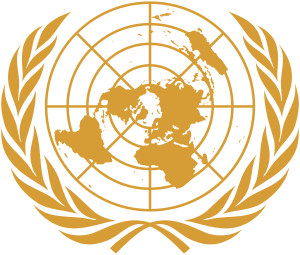Committee on the Rights of the Child
The Committee on the Rights of the Child (CRC) is a body of experts that monitor and report on the implementation of the United Nations Convention on the Rights of the Child.[1][2]
 | |
| Abbreviation | CRC |
|---|---|
| Formation | 1991 |
| Type | United Nations Committee |
| Legal status | Active |
| Headquarters | Geneva, Switzerland |
Head | Chair Luis Ernesto Pedernera Reyna |
| Website | www.ohchr.org/en/hrbodies/crc |
The Committee also monitors the Convention's three optional protocols: the Optional Protocol on the Involvement of Children in Armed Conflict, the Optional Protocol on the Sale of Children, Child Prostitution and Child Pornography and the Optional Protocol to the Convention on the Rights of the Child on a Communications Procedure.[3]
History and organization
The CRC is one of the ten UN human rights treaty-based bodies.[4] The Committee was created by the Convention on 27 February 1991.[5] The Committee is made up of 18 members from different countries and legal systems who are of 'high moral standing' and experts in the field of human rights. Although members are nominated and elected by States party to the Convention, Committee members act in a personal capacity. They do not represent their countries' governments or any other organization to which they might belong. Members are elected for a four-year term and can be re-elected if nominated.
The 195 states that have ratified the Convention ("States party to the Convention") (which includes all UN member states except Somalia and the United States, South Sudan ratified on 23 January 2015) are required to submit initial and periodic reports on the national situation of children's rights to the Committee for examination. The Committee examines each report and raises concerns or makes recommendations to the State party. It also issues occasional general comments on the interpretation of particular Convention obligations. Once a year, the Committee submits a report to the Third Committee of the United Nations General Assembly, which also hears a statement from the CRC Chair, and the Assembly adopts a Resolution on the Rights of the Child.[6][7]
The Committee cannot consider individual complaints, although child rights may be raised before other committees with competence to consider individual complaints.[8] However, at least the case of Gendhun Choekyi Nyima, 11th Panchen Lama, was considered by the Committee on 28 May 1996, as well as at other later dates.[9]
In November 2014, for the first time, the Committee joined with the Convention on the Elimination of All Forms of Discrimination against Women to release a comprehensive interpretation of the obligations of States to prevent and eliminate harmful practices done to women and girls.[10]
Members
The current members of the Committee on the Rights of the Child are listed on the Web site of the Office of the UN Commissioner for Human Rights.[11] Information on former CRC members is linked from the same Web page.
Periodic Report on the Holy See
In February 2014 the Committee, after interviewing two top officials of the Catholic Church, published observations[12] described as "a scathing indictment of the Vatican’s handling of child sexual abuse cases involving clerics, releasing a report that included criticism of church teachings on homosexuality, gender equality and abortion".[13] The Holy See released a critical statement and said that it did not appreciate being asked to change its position on issues it considered immutable. Archbishop Silvano Tomasi, the Holy See's permanent observer at the UN, said that he suspected pro-gay rights NGOs had influenced the committee and "reinforced an ideological line" in the UN. Advocates for the survivors of clerical sex abuse welcomed the committee's findings.[14][15]
See also
- Child helpline international
- The International Centre for Missing & Exploited Children (ICMEC), combats child sexual exploitation, child pornography, and child abduction
References
- . New York: United Nations Treaty Collection. 1989 – via Wikisource.
- Volger, Helmut, ed. (2010). A Concise Encyclopedia of the United Nations (2nd ed.). Leiden: Martinus Nijhoff. pp. 326–329. ISBN 978-90-04-18004-8.
- Manhire, Vanessa, ed. (2019). United Nations Handbook 2019–20 (PDF) (57th ed.). Wellington: Ministry of Foreign Affairs and Trade of New Zealand. pp. 293–294. ISSN 0110-1951.
- "OHCHR | Human Rights Bodies". www.ohchr.org. Retrieved 23 April 2017.
- "www.humanium.org: Committee on the Rights of the Child - What it is and how it works". Retrieved 15 November 2014.
- Child Rights Information Network (2008). Convention on the Rights of the Child Archived 3 November 2012 at the Wayback Machine. Retrieved 26 November 2008.
- Resolution on the Rights of the Child, 21 November 2012.
- Human Rights Bodies - Complaints Procedures
- Gedhun Choekyi Nyima: the XIth Panchen Lama of Tibet Archived 24 March 2008 at the Wayback Machine website of TCHRD
- "UN human rights experts set out countries' obligations to tackle harmful practices such as FGM and forced marriage". United Nations Human Rights, Office of the High Commissioner for Human Rights. 5 November 2014. Retrieved 15 November 2014.
- Office of the UN Commissioner for Human Rights: Members of the CRC
- Committee on the Rights of the Child: Concluding observations on the second periodic report of the Holy See, 31 January 2014 draft published on the Washington Post Web site
- Faiola, Anthony; Boorstein, Michelle (5 February 2014). "U.N. panel blasts Vatican handling of clergy sex abuse, church teachings on gays, abortion". The Washington Post. Retrieved 15 November 2014.
- Katherine Gallagher, a senior staff attorney at the US-based Centre for Constitutional Rights was among those who welcomed the Committee's findings on sex abuse within the Catholic Church
- Davies, Lizzy; McDonald, Henry (5 February 2014). "Vatican envoy rejects UN panel's critical verdict on clerical abuse scandal". The Guardian. London.
External links
- Committee on the Rights of the Child at OHCHR website
- www.humanium.org: Committee on the Rights of the Child - What it is and how it works